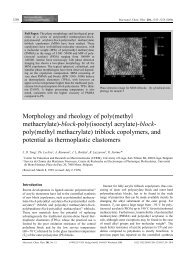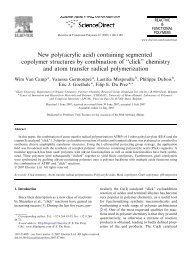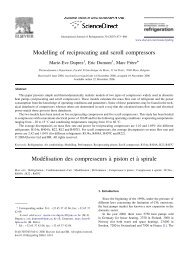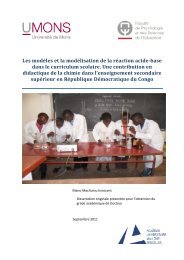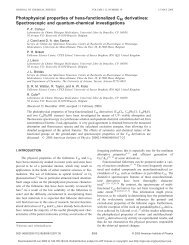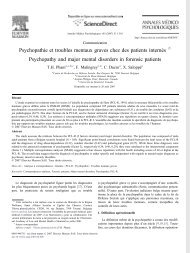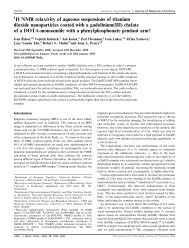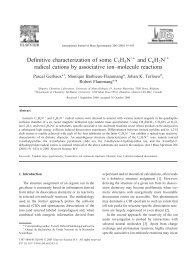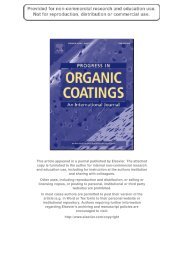Synthesis and bulk properties of poly(methyl methacrylate)-b- poly ...
Synthesis and bulk properties of poly(methyl methacrylate)-b- poly ...
Synthesis and bulk properties of poly(methyl methacrylate)-b- poly ...
You also want an ePaper? Increase the reach of your titles
YUMPU automatically turns print PDFs into web optimized ePapers that Google loves.
4622<br />
J.D. Tong et al. / Polymer 41 (2000) 4617–4624<br />
Fig. 6. Stress–strain behavior <strong>of</strong> SIPS (14K–109K–14K; 13 wt% PS) <strong>and</strong> MIM (40K–300K–40K; 21 wt% PMMA).<br />
over MIM, which in this example, has, however, the advantage<br />
<strong>of</strong> higher MW <strong>and</strong> content <strong>of</strong> the hard block.<br />
In order to explain the basic difference in the behavior <strong>of</strong><br />
the diene-containing triblocks <strong>and</strong> the fully acrylic ones, it is<br />
worth referring to papers by Holden <strong>and</strong> Legge [18–20] <strong>and</strong><br />
Quirk <strong>and</strong> Morton [19], who noted that the slippage <strong>of</strong> the<br />
entangled central blocks <strong>of</strong> triblocks could share the applied<br />
force so delaying the ductile failure <strong>of</strong> the hard microdomains.<br />
Furthermore, Ver State et al. reported that G N<br />
o<br />
(plateau modulus, see also Eq. (1)) has a dominant effect<br />
on the curemeter torque (M H ) for a series <strong>of</strong> vulcanized<br />
elastomers with the same chemical crosslinking density<br />
[21,22]. They pointed out that the mechanical <strong>properties</strong><br />
(modulus <strong>and</strong> strength) <strong>of</strong> vulcanized elastomers are<br />
strongly influenced by chain entanglements. Therefore, it<br />
appears that the ability <strong>of</strong> the central block to form entanglements<br />
is essential for the parent triblock to be a good<br />
Fig. 7. Master curves (G 0 , G 00 <strong>and</strong> tan d) for PIOA (M n ˆ 210K;<br />
M w =M n ˆ 1:10) at 20C. Dashed lines indicate the position <strong>of</strong> tan d min<br />
<strong>and</strong> the value <strong>of</strong> G o N:<br />
thermoplastic elastomer. The average molecular weight<br />
between chain entanglements, M e , is very low in the case<br />
<strong>of</strong> PBD (1700) <strong>and</strong> PIP (6100) [18]. M e for PIOA has been<br />
determined from viscoelastic data according to Eq. (1) [23–<br />
26]<br />
M e ˆ rRT=G o N<br />
…1†<br />
where r is the <strong>poly</strong>mer density, R is the gas constant, T is<br />
the absolute temperature <strong>and</strong> G o N ˆ G 0 …tan d ! min:† is the<br />
shear modulus <strong>of</strong> the viscoelastic plateau. Fig. 7 shows the<br />
master curves for homo-PIOA (210,000) at 20C. Calculated<br />
from the G o N value, M e is exceedingly high (ca. 60,000)<br />
compared to <strong>poly</strong>dienes. Since the entanglement density for<br />
the central block is inversely proportional to M e ,itmustbe<br />
very limited in MIM triblocks compared to diene based<br />
TPEs, all other characteristics being the same (molecular<br />
weight <strong>and</strong> composition). Consistently, we have recently<br />
examined the ultimate mechanical <strong>properties</strong> <strong>of</strong> a series <strong>of</strong><br />
PMMA–<strong>poly</strong>(alkyl acrylate)–PMMA triblock co<strong>poly</strong>mers<br />
with alkyl groups ranging from 2–8 carbon atoms, thus M e<br />
for <strong>poly</strong>(alkyl acrylates) ranging from 11,000 to 60,000. The<br />
ultimate tensile strength was found to increase linearly with<br />
1/M e [27].<br />
The main consequence <strong>of</strong> the very significant increase in<br />
M e when a rubbery <strong>poly</strong>acrylate block is substituted for the<br />
<strong>poly</strong>diene one in triblock TPEs is that the tensile behavior <strong>of</strong><br />
the MIM triblocks should be accounted for by the rubber<br />
elasticity theory [28] at low to moderate elongations, rather<br />
than by the “rubber filler” model which fits the behavior<br />
<strong>of</strong> the <strong>poly</strong>diene-based TPEs. The SIPS tensile behavior is<br />
indeed properly accounted for by the classical rubber elasticity<br />
law modified by the filler effect [29]:<br />
<br />
s ˆ rRT 2C <br />
2<br />
l 1 <br />
<br />
M c l l 2 1 2:5f S 14:1f 2 S …2†<br />
where s is the applied tensile strength, l is the extension<br />
rate; M c is the average molecular weight between crosslinks<br />
(here close to M e ), C 2 is a constant related to deviation from<br />
the ideal elastic behavior, <strong>and</strong> f s is the volume fraction <strong>of</strong>



